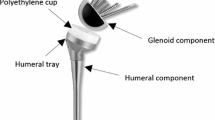Abstract
The application of a design methodology for the determination of the optimal prosthesis architecture for a given upper limb amputee is presented in this paper along with the discussion of its results. In particular, a novel procedure was used to provide the main guidelines for the design of an actuated shoulder articulation for externally powered prostheses. The topology and the geometry of the new articulation were determined as the optimal compromise between wearability (for the ease of use and the patient’s comfort) and functionality of the device (in terms of mobility, velocity, payload, etc.). This choice was based on kinematic and kinetostatic analyses of different upper limb prosthesis models and on purpose-built indices that were set up to evaluate the models from different viewpoints. Only 12 of the 31 simulated prostheses proved a sufficient level of functionality: among these, the optimal solution was an articulation having two actuated revolute joints with orthogonal axes for the elevation of the upper arm in any vertical plane and a frictional joint for the passive adjustment of the humeral intra-extra rotation. A prototype of the mechanism is at the clinical test stage.




Similar content being viewed by others
References
Anglin C, Wyss UP (2000) Review of arm motion analyses. Proc Inst Mech Eng [H] 214(5):541–555. doi:10.1243/0954411001535570
Atkins DJ, Meier RHIII (1989) Comprehensive management of the upper-limb amputee. Springer, New York
Borghi C, Troncossi M, Parenti-Castelli V et al (2007) A new protocol for experimental determination of human hand reference trajectories for the synthesis of upper limb prostheses. In: Proceedings of the AIMETA 2007, Brescia, Italy, September 2007
Cattaneo B, Casolo F, Camposaragna M et al (2001) An innovative shoulder complex with two active axes for artificial upper limbs. In: Proceedings of the ISB, Zurich, Switzerland, July 2001, p 221
Dennis JE, Schnabel RB (1996) Numerical methods for unconstrained optimization and nonlinear equations. SIAM, Philadelphia
Dillingham TR, Pezzin LE, MacKenzie EJ (2002) Limb amputation and limb deficiency: epidemiology and recent trends in the United States. South Med J 95(8):875–883
Garcìa de Jalon J, Bayo E (1994) Kinematic and dynamic simulation of multibody systems: the real-time challenge. Springer, New York
Gow DJ, Douglas W, Geggie C et al (2001) The development of the Edinburgh modular arm system. Proc Inst Mech Eng [H] 215(3):291–298. doi:10.1243/0954411011535885
Gruppioni E, Chiossi M, Davalli A et al (2008) A new actuated prosthetic shoulder: from the design to the first in vivo test. In: Proceedings of the MEC’08, New Brunswick, Canada, August 2008
Higashihara T, Saito Y, Itoh H (1987) The development of a microcomputer-controlled electrical prosthesis with six degrees of freedom. In: Proceedings of the IFToMM 7th congress, vol 3. pp 1841–1844
Hungspreugs P, Heckathorne CW, Childress DS (2000) Computer simulation tool for upper-limb prosthesis design. In: Proceedings of the EMBS, Chicago, USA, July 2000, pp 1964–1967
Jiménez P, Thomas F, Torras C (2001) 3D collision detection: a survey. Comput Graph (ACM) 25(2):269–285. doi:10.1016/S0097-8493(00)00130-8
Klopčar N, Lenarčič J (2005) Kinematic model for the determination of human arm reachable workspace. Meccanica 40(2):203–219. doi:10.1007/s11012-005-3067-0
McWilliam RP (1970) A list of everyday tasks for use in prosthesis design and development. Bull Prosthet Res 10(13):135–164
Miguelez JM (2002) Critical factors in electrically powered upper-extremity prosthetics. JPO 14(1):36–38
Paul RB (1981) Robot manipulators: mathematics, programming, and control (artificial intelligence). MIT Press, Cambridge
Ramanathan R, Eberhardt SP, Rahman T et al (2000) Analysis of arm trajectories of everyday tasks for the development of an upper-limb orthoses. IEEE Trans Rehabil Eng 8(1):60–70. doi:10.1109/86.830950
Romilly DP, Anglin C, Gosine RG et al (1994) A functional task analysis and motion simulation for the development of a powered upper-limb orthosis. IEEE Trans Rehabil Eng 2(3):119–129. doi:10.1109/86.331561
Simpson DC, Kenworthy G (1973) The design of a complete arm prosthesis. Biomed Eng 8(2):56–59
Stanger CA, Anglin C, Harwin WS et al (1994) Devices for assisting manipulation: a summary of user task priorities. IEEE Trans Rehabil Eng 2(4):256–265. doi:10.1109/86.340872
Troncossi M, Parenti-Castelli V (2007) Synthesis of prosthesis architectures and design of prosthetic devices for upper limb amputees. In: Rehabilitation robotics. I-Tech Education and Publishing, Vienna, pp 555–578
Troncossi M, Parenti-Castelli V, Chiossi M et al (2007) Experimental characterization of prosthetic mechanisms with one-degree of freedom. In: Proceedings of the AIMETA 2007, Brescia, Italy, September 2007
Weir RF, Grahn EG (2005) Powered humeral rotator for persons with shoulder disarticulation amputations. In: Proceedings of the MEC’05, New Brunswick, Canada, August 2005
Author information
Authors and Affiliations
Corresponding author
Rights and permissions
About this article
Cite this article
Troncossi, M., Borghi, C., Chiossi, M. et al. Development of a prosthesis shoulder mechanism for upper limb amputees: application of an original design methodology to optimize functionality and wearability. Med Biol Eng Comput 47, 523–531 (2009). https://doi.org/10.1007/s11517-009-0465-9
Received:
Accepted:
Published:
Issue Date:
DOI: https://doi.org/10.1007/s11517-009-0465-9




